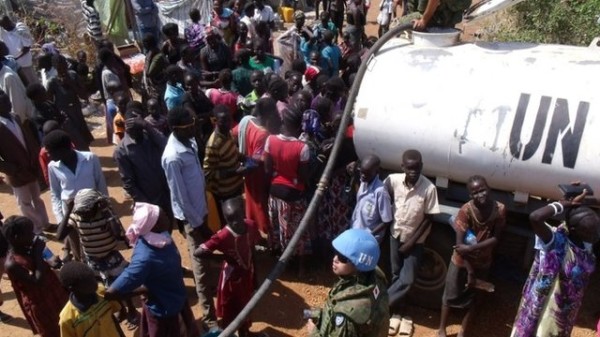
The UN peacekeeping mission is sheltering civilians in five state capitals
The United Nations says it fears casualties after attackers forced their way into a peacekeeping base in South Sudan’s Jonglei state.
Rebels from the country’s second-largest ethnic group, the Nuer, attacked the base, targeting civilians of the majority Dinka ethnic community.
South Sudan has been in turmoil since President Salva Kiir accused his ex-deputy Riek Machar of mounting a coup.
The unrest, which broke out on Sunday, has killed some 500 people so far.
The conflict first erupted in the capital Juba but has since spread.
President Salva Kiir, from the Dinka, has blamed the violence on a group of soldiers who support Mr Machar, a Nuer.
The president accuses them of trying to take power by force on Sunday night in a coup attempt by Mr Machar – something Mr Machar denies.
The UN has expressed concern about a possible civil war between the Dinka and the Nuer.
However, the government insists the clashes are over power and politics, noting that both sides involved in the clashes include leaders from different tribes.
“We condemn in strongest possible terms attempts to depict the coup as ethnic strife,” a government statement said.
‘We want him to leave’ UN spokesman Farhan Haq told reporters on Thursday that “fighting took place” at the compound in the remote town of Akobo in Jonglei

Thousands of people have fled the fighting in the north of the country
“We fear there may have been some fatalities but can’t confirm who and how many,” he said, warning that the situation in Akobo was deteriorating.
The spokesman said the attackers, mainly youth, had targeted 32 civilians from the Dinka, who had sought refuge at the base.
He added that 60 troops from the peacekeeping mission would reinforce the compound.

President Salva Kiir blames his former vice-president for the violence

Foreign nationals, and many locals too, are trying to leave the country as fears of a civil war mount
The UN is sheltering more than 30,000 civilians in five state capitals, including Juba and Bor.
The attack on the Jonglei base came after Nuer rebels seized control of Bor. Even before the unrest, Bor was seen as one of the most volatile areas of South Sudan.
Earlier, there were reports of gun battles in the key town, as renegade officers fought with troops still loyal to the president.
In an interview with Radio France Internationale, Mr Machar called on the army to remove the president.
“We want him to leave, that’s it,” he told the station.
Mr Machar was sacked by Mr Kiir in July.
The UN has called for political dialogue to end the crisis, and the Ugandan government says its president has been asked by the UN to mediate between the two sides.
A delegation of East African foreign ministers earlier arrived in Juba to try to mediate in the crisis.
Britain and the US have both sent planes to airlift their nationals out of the country, and a US defence official described the situation as “getting ugly”.
South Sudan has struggled to achieve a stable government since becoming independent in 2011.
The oil-rich country remains ethnically and politically divided, with many armed groups active.
Profile: Riek Machar

- Central figure in Sudanese and South Sudanese politics for three decades
- Member of South Sudan’s second-largest ethnic group, the Nuer
- Was a Sudan People’s Liberation Movement (SPLM) commander and led a breakaway faction for some years in the 1990s
- After 2005 peace deal appointed vice-president of interim government, retaining the post after independence in 2011 until his dismissal in July 2013

Both Sudan and the South are reliant on oil revenue, which accounts for 98% of South Sudan's budget. They have fiercely disagreed over how to divide the oil wealth of the former united state - at one time production was shutdown for more than a year. Some 75% of the oil lies in the South but all the pipelines run north.

The two Sudans are very different geographically. The great divide is visible even from space, as this Nasa satellite image shows. The northern states are a blanket of desert, broken only by the fertile Nile corridor. South Sudan is covered by green swathes of grassland, swamps and tropical forest.

Sudan's arid north is mainly home to Arabic-speaking Muslims. But in South Sudan there is no dominant culture. The Dinkas and the Nuers are the largest of more than 200 ethnic groups, each with its own languages and traditional beliefs, alongside Christianity and Islam.

In the Sudanese states of Khartoum, River Nile, and Gezira states, two-thirds of people have access to piped drinking water and pit latrines. In South Sudan, boreholes and unprotected wells are the main drinking sources. More than 80% of South Sudanese have no toilet facilities.

Throughout the two Sudans, access to primary school education is strongly linked to household earnings. In the poorest parts of the south, less than 1% of children finish primary school. Whereas in the wealthier north, up to 50% of children complete primary level education.

Conflict and poverty are the main causes of food insecurity in both countries. In Sudan, many of the residents of war-affected Darfur and the border states of Blue Nile and South Kordofan depend on food aid. The UN says about 2.8m people in South Sudan required food aid in 2013.



Leave a reply